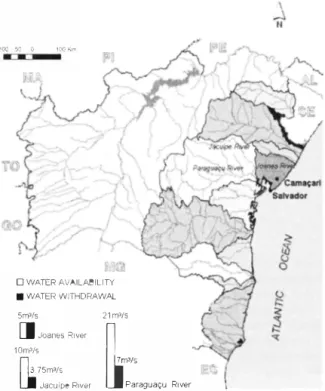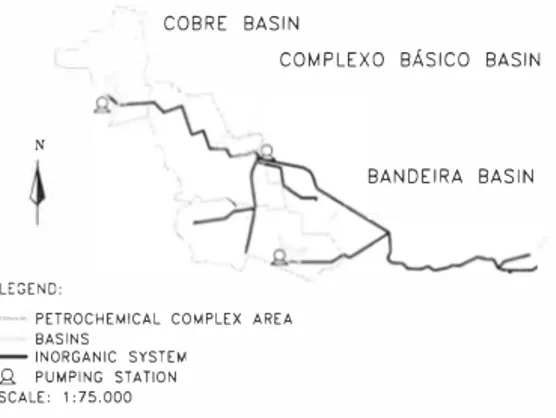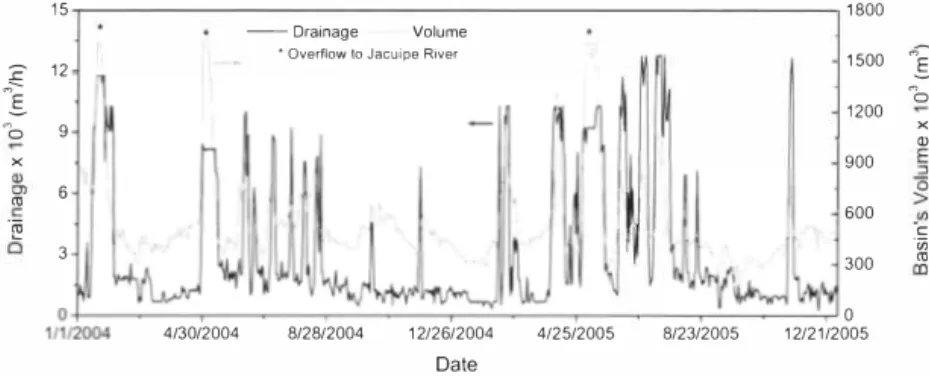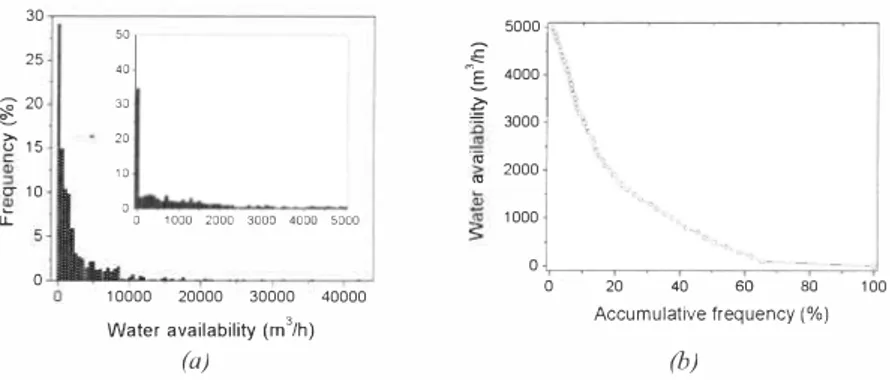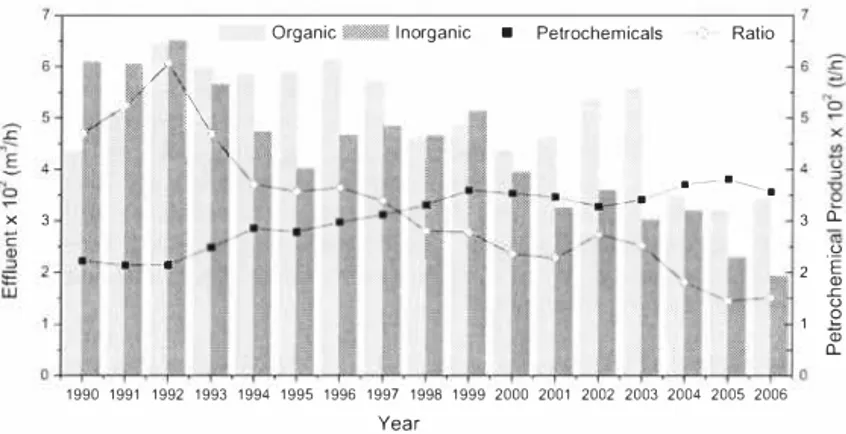ASSESSMENT OF WATER AVAILABILITY
WITHIN A HEAVY INDUSTRIALIZED REGION
Karla Oliveira-Esquerre
1, Asher Kiperstok
1, Eduardo Cohim
1,
Ricardo Kaiid
1, Emerson Sales
1, Mario Cezar Mattos
1,
Fabio Menezes
1, Laysa Lima
1,Samara Silva
1Rodolfo Schubach
2Jose Batista
3 1Federal University of Bahia, Brazil
2Braskem - Basic Petrochemical Unit, Brazil
3Cetrel - Environmental Protection Company, Brazil
ABSTRACT
Water conflict and scarcity is a present reality world-wide, For high peak demands, hydrologic limitations required either finding a bigger source or building sufficient storage. This paper provides a well-documented case study of water reuse by proposing alternative industrial water harvest at the largest petrochemical complex of Latin America located at the State of Bahia, Brazil. Water balance concepts were used to access the water availability. The obtained results imply in an averaged natural resources economy of 1,250 m3/h of water, which can be used alternatively to either human consumption or energy generation in Bahia's semi-arid regions.
KEYWORDS
Water reuse; Attenuation reservoir; Camayari petrochemical complex. I INTRODUCTION
In the Brazilian Semi-Arid Region, the scarcity of water for human consumption is still a social tragedy, especially during droughts. The State of Bahia is the largest state in the northeast of Brazil, with a population of 13 million inhabitants and an area covering over one half million km2 [I]. Despite boasting Brazil's fifth largest economy, the State suffers from an incidence of poverty almost twice the national average. Less than a quarter of the rural population has access to proper sanitation facilities and only I 0% has reliable access to safe water. In fact, water demand with respect to the total availability is not so high but water resources are unevenly distributed in both time and location. The Central and North regions of the State are characterized by scarce and highly irregular rainfall in contrast to plentiful water supply and greater rainfall in the West, South and coastal regions.
The Reconcavo Geological Basin is located in the coastal hydrographic region and contemplates an enormous variety of rivers, streams and brooks, the majority of which is intermittent and seasonal. Until late 70's, mainly Joanes and Jacufpe rivers supplied water to the densest occupied area of the State including the metropolitan region of Salvador and a petrochemical complex in Camayari (see Figure !).
:00 '.:>(; ti 1Ct1 Kir•
□
WATER AVAILABILITY■
WATER WITHDRAWAL Sm'/s 21m'/S[I
Joanes R1 ver 10m3/sn
m'/s n375m'/sLI
Jacuipe Riverli
Paragua,u River Figure I. Natural resources of the Reconcavo Geological Basin.As water demand for human consumption and industry have been growing,.the ratio between water supply and demand from the Joanes and Jacuipe rivers at the Reconcavo Basin declined. The Government decided to harvest water from Paragua�u watershed, located in a semi-arid region and about I 00 km far from Salvador. Figure 2 presents the increase of water availability to the Salvador's metropolitan region by using accumulated water from dams.
0.08 006 0 04 0 02 0 X 3 Cl) E :, al 2 iii :, E 1 u u <( 1920 1930 1940 1950 1960 1970 1980 1990 2000 2010 Year
Figure 2. Accumulated waterfi·om dams /2}.
Nowadays, about 40% of the Bahia State population lives in the metropolitan region of Salvador, demanding on average 43,200 mel/h of water, whereas the Petrochemical Complex
in Camai;:ari comprises more than 60 plants [3] and requires on average 5,700 ml/h of water to
produce more than 8 millions tons per year of chemical and petrochemical products. While the Petrochemical Complex harvests water from the Joanes river, and groundwater from the Sao Sebastiao aquifer, the main source (58%) of water to the metropolitan region is the Paraguai;:u river, To date, the energy required to pump water from Paraguai;:u watershed to the metropolitan region of Salvador is supplied by Companhia Hidro Eletrica do Sao Franciso (CHESF), a Brazilian government-owned electric power generation company though the Paulo Afonso system, located in the northeast region of the State of Bahia. For each I mel
pumped to Salvador, about 6 ml of water are used in the hydraulic power generation by
CHESF.
Besides water demand conflicts, the water courses of the metropolitan region of Salvador and the Rec6ncavo basin receive effluent from the Petrochemical Complex, pesticides and domestic sewage, The 'Environmental Protection Company' called Cetrel has the specific mission to operate and manage all aspects of industrial wastes and to preserve the environment in the area under the influence of the Petrochemical Complex [4],
In 1989, the duplication of the Petrochemical Complex boosted a significant number of water disposal regulations in tenns of quality and quantity forcing the industries to treat or reduce its pollutants within its plants and to adopt new polices of pollution control and water reuse [5, 6], Six years later, in 1995, the Superintendence for Water Resources (SRH), subordinated to the Secretariat of Environment and Water Resources (SEMARH), was created by the State Government (Law 6855) to improve water resources planning and management, and resolve or minimize the State's complex problems of water scarcity, water conflicts and watershed conservation [I], From 2003 to 2005, Bahia's Water Resource Management Plan was fonnulated focusing the implementation of a monitoring and infonnation network to maximize water management efficiency.
has providing additional infonnation and support to the management of these resources. Consequently, public offices and industries have been continuously stimulated to implement environmental management systems. This requires increasing inputs of labor, information technology and energy into water use management and overall maximum reuse policies. Among these industries is the Braskem Basic Petrochemical Unit located in the Petrochemical Complex.
Besides primary olefin and aromatics products, Braskem produces electric power, steam, compressed air, and clarified, drinking and demineralized water for internal use and for all the other companies in the Petrochemical Complex. The company generates approximately 70% of the Petrochemical Complex's energy consumption requirements, and 90% of industrial water demand.
A joint research program between Braskem and the Clean Technology Network (Teclim) of the Federal University of Bahia (UFBA) has been developed since 2002. The research program, called EcoBraskem, has promoted water use optimization as a result of a water balance methodology [6, 7) by evaluating the hydrological characteristics of the region and the availability of water sources and consumers with compatible physical/chemical characteristics.
Three reservoirs have been operated by Cetrel as attenuation basins, part of an end-of-pipe system, receiving rainwater contaminated with inorganic effluents, and eventually with organics, before their discharge trough a submarine outfall. With a volume of about 1,600 mill ion m3, the main reservoir is called Complexo Basico attenuation basin.
After 30-year operation, this basin was identified during this research program as a reliable alternative water source for industrial usage. Water balance concept was used to assess water availability from this reservoir, based on the daily volume variation and flow rate of inorganic effluent. For the estimated availability average of 1,250 m3/h from this basin to industrial
usage, the public owned water supply company may increase ca. 3 % the water extraction from Joanes River to human consumption, and, consequently, reduce water extraction and pumping from sources far away from Salvador's consumers.
The structure of this paper is as follows. First, a description of the inorganic effluent system is given. Then, modeling approach is briefly described and the results of modeling are reported. Finally, the conclusions are drawn.
2 THE INORGANIC SYSTEM
The Camayari Petrochemical Complex -the most industrialized area of Latin America -is located in the Bahia's coastal area, 45 km far from Salvador, on top of the Sao Sebastiao aquifer and surrounded by various superficial water resources at the Rec6cavo Geological Basin. About 2500 m3/h of inorganic and organic effluent are produced by the Petrochemical Complex, and are disposed into separated drainage systems.
The inorganic effluent drainage system at the Petrochemical Complex is composed by a net of collecting open channels of 30 km of extension, three attenuation basins (each one with pumping stations) and a main channel that conducts the inorganic effluents to a submarine
COBRE BASIN
COMPLEXO BASICO BASIN
N
BANDEIRA BASIN
LEGEND,
,~,, PETROCHEMICAL COMPLEX AREA
BASINS
- INORGANIC SYSTEM Q PUMPING STATION SCALE, 1,75,000
Figure 3. Schematic sketch of the inorganic effluent drainage �ystem (PS: Pumping Station), The pumping station located just after the Complexo Basico basin is responsible to pump contaminated water from the inorganic system to Cetrel and, subsequently, to the submarine outfall. The averaged total pumped flow rate of inorganic effluent is ca. 1,000 m3/h, and the major contributions come from Braskem-UNIB and from a metallurgic industry with 350 m l/h and 140 m 3/h, respectively. The three attenuation basins have been designed to accumulate temporally the inorganic effluents and rainwater during intense raining periods, avoiding that contaminated water reaches Jacuipe and Joanes rivers, In this sense, contaminated water stored in the Cobre and Bandeira basins is also pumped to the main channel. To reduce the possibility of contaminated material reaching Jacuipe and Joanes rivers, the, basins are operated at 70%, Some specific characteristics of these basins are shown in Table I,
Table I, Attenuation basins characteristics at the Petrochemical Complex.
Original capacity (ml ) Actual capacity 1 (1w ) Pumping station capacity (1113/h) Potential overflow risk Complexo Basico Basin 2,021.00 0 1,600,00 0 12,000 Jacuipe River Cobre Basin Bandeira Basin 8 I 3,000 622,000
--
4,500 2,500 Joanes RiverThe actual capacities are lower than the original ones because in the early stages of the Petrochemical Complex construction and operation, significant soil works occurred, provoking erosion of the basins.
·�
X
Equation 1 describes the water balance at the basin:
(I) where VA represents the rainwater volume and possible natural flow of groundwater that reaches the basin, t,V/ 6.t is the change in stored water volume over one-day period, Qp is the
volume of contaminated water pumped to the submarine outfall and Q1 is the mean volume of inorganic effluent produced in the Petrochemical Complex. In this research, VA is considered the volume of water available to reuse.
Figure 4 shows the changes in the basin water volume and pumping flow rate for two-year period provided by Cetrel. As expected, an increase in the pumping flow rate follows, and sometimes antecedes, the increasing of the water volume in order to keep the basin at a maximum of 70% of its capacity. Nevertheless, some overflow periods to Jacuipe River were observed. This phenomenon confronts with the basic concept of the basin project, that is, to work as an attenuation reservoir with the capacity to accumulate flood volumes.
15
--Drainage Volume
• Overflow to Jacuipe River 12 :2 M-.s 0 9
"'
6 3 413012004 8128/2004 12/26/2004 4/2512005 Date 812312005 12/2112005 1800 1500 M .s M Q 1200 X Q) 900 600 -c ·.;"'
300 0Figure 4. Water volume of the Complexo Basico Basin and pumped flow rate (2004 and 2005).
As mentioned, the averaged total flow rate of inorganic effluent pumped to the submarine outfall is ca. 1,000 m3/h, at nonnal operation. However, pumping reaches up to 13,000 me3/h
during high pluviosity and shows an annual average of 3,000 m3 /h. Consequently, about 2,000
me3/h of water of good quality has been discarded.
4 MODELING RES UL TS
Figure 5a shows the obtained results for water availability using water balance concepts. As expected, the distribution is right-skewed where 30% of the data is zero and 96% of the data show flow rates below the pumping capacity (13,000 me3/h). Figure 5b pictures the accumulative frequency data considering the current water treatment capacity of the water
-�
�
ij' 15
40
averaged volume of 1250 m3/h of water from the Complexo Basico basin is available for
industrial usage. 30 5000 50 25 40
.s
4000 � 20 3J�
3000 C' 10 0·.,
u:
0 1000 2000 3000 4000 5000 1000 a a a 20"'
2000 10 60 20 BO 100 10000 20000 30000 40000 3 Accumulative frequency(%) Water availability (m /h) (a) (b)Figure 5: Results of water availability by using water balance concepts.
This result was compared with those obtained by using the Soil Conservation Service curve number method [8]. Using the SCS method, the annually averaged volume found was 73% lower than the estimated by using the water balance approach. Such difference may be explained by some water sources considered only in the water balance calculus. Besides possible natural flow of groundwater into the basin, indirect contributions of the Cobre and Bandeira basins into the Complexo Basico Basin should be considered, especially during raining periods. Consequently, the SCS prediction runoff method prediction needs some improvements to suit these contributions,
The reuse of about 1250 m3/h of water accumulated in the Complexo Basico attenuation basin
implies in the decentralization of industrial water harvest at Camayari, and, consequently, the availability of the same amount of water in the same amount for human consumption. Throughout changing some operational procedures of the inorganic system, the basin may operate as accumulation basin and, consequently, increase the amount of available water. The proposed procedure includes the installation of a gate isolating the basin and the main channel of the inorganic system, and the operation at over 30% of its capacity,
5 ECONOMIC AND ENVIRONMENTAL BENEFITS TO THE COMMUNITY
The goal of water supply system has been to provide clean water abundantly and inexpensively [9], As a result, the flux of the hydrological cycle of the regions has created environmental limitations in getting abundant clean raw water to human, agriculture or industrial consumption. To overcome the resources conservation challenge in the Petrochemical Complex, efficient and sustainable use of water resources must be promoted. Besides allowing a major protection of the water resources of the region, the reuse proposed in this research represents a considerable reduction of both water volume extracted from the regional water resources to industrial usage and inorganic effluent disposal to the submarine outfall,
demand of the Petrochemical Complex and about 40% of the contaminated water is discharged to the submarine outfall. Consequently, together with the economy of energy for harvesting water from the basin instead of Joanes river, there is a reduction of about 40 % in
energy consumption by pumping 1,250 m3/h to the submarine outfall. This result is even more
meaningful if one considers that the public owned water supply company may increase at about 3% the water extraction from Joanes River, and, consequently, reduce water extraction and energy consumption by pumping water from sources in the semi-arid located far away from Salvador's consumers.
By increasing the appreciation of Braskem/UNIB for the value and vulnerability of the natural resources as well as the importance of rational water use practices, this research is helping to close the loop between water supply and wastewater disposal within the Petrochemical Complex. A positive changing picture of Braskem 's effluent production has been observed (Figure 8).
Organic mffl Inorganic ■ Petrochemicals Ratio
/
I\
■-·--.-
·
3 o,_ X 3-
•
u 2 -� .c u 1 e a, o,_ 1990 1991 1992 1993 1994 1995 1996 1997 1998 1999 2000 2001 2002 2003 2004 2005 2006 YearFigure 8: Effluent generation and petrochemical production by Braskem/UN/8 (ratio: total e/jluentlpetrochemicalJ).
6 CONCLUSIONS
Future problems which impinge upon regional economic development by water conflict stemming from competing uses and water scarcity can be mitigated by optimizing the allocation and use of water resource. This research deals with water reuse within an industrialized region by considering hydrological aspects related to urban and industrial water supply priorities.
Water balance approach was used to access the water availability of an attenuation reservoir, based on the daily volume variation and flow rate of inorganic effluent for two-year period. An annual average availability of 1,250 m3/h was estimated for a maximum water treatment capacity of 3,200 m3/h.
[5]
Reduction of 40% of the actual industrial harvest from Joanes river;
Increasing of about 3% of the actual human water harvest from Joanes river, and, consequently, the reduction of the same amount of water harvested from Paragua<;u watershed;
Reduction of about 40% of contaminated water discarded to the submarine outfall ; Reduction of energy consumption to pump 1,250 m3/h of contaminated water to the
submarine outfal l and, especially, to bring water from Paragua<;u watershed.
These results stimulated the development of an engineering project that supports the proposed reuse. An integrated study of new opportunities and treats considering various policies interventions is in course for achieving a gradative reduction of inorganic effluent volume within the Petrochemical Complex.
The establishment of the association of water users and the planning, implementation and strengthening of water resources management action are considered in the Water Resource Management Plan of the State of Bahia [ I ]. A Director Plan of Water Resources Management has been elaborated by Braskem.
ACKNOWLEDGMENT
The authors gratefully acknowledge the Conselho Nacional de Desenvolvimento Cientifico e Tecno16gico (CNPq), Financiadora de Estudos de Projetos ( F INEP) and Braskem/UNIB for the financial support and Cetrel S.A., Centro de Recursos Ambientais (CRA) and Faculdade de Tecnologias e Ciencias ( FTC) for the technical support.
RE FEREN C E S
[I] Plano Estadual d e Recursos Hidricos ( Bahia's Water Resource Management Plan),
PERH-Ba. 2004 (in Por111g11ese).
[2] Bezerra, A. P. , 2006. Os Recursos Hidricos e a Gestao Publica: Perdas devido
a
degrada<;ao de Mananciais de Abastecimento de Agua na Cidade de Salvador-Ba. Master Dissertation, FTC-Faculdade de Tecnologia e Ciencias, Salvador, Bahia, Brasil(in Porluguese).
[3] Klumpp, A. , Hintemann, T. , Lima, J. S., Kandeler, E., 2003. Bioindication of air pollution effects near a copper smelter in using mango trees and soil microbiological properties, Environmental Pollution, I 26, 3 13-32 1.
[4] Verstraete, W. , 2002. Environmental biotechnology for sustainability, Journal of Biotechnology, 94, 93 - 100.
Marinho, M., Kiperstok, A. , 200 1. Ecologia Industrial e Preven<;ao da Polui<;ao: Uma Contribui<;ao ao Debate Regional , Bahia Analise & Dados, v. I 0, n.4, p.27 1-279, 200 I .
[6] Kiperstok, A., Kalid, R. , Sales, E. , 2006. Development of water and wastewater minimization tools for the process industry: the experience of the Clean Technology Network of Bahia, Brazil. Annals of Global Conference on Susrainable Product Development and Lfe Cycle Engineering, 4. , 2006, Sao Carlos, Sao Paulo, Brazil. [7] Fontana, D , Kai id, R , Kiperstok, A, Silva, M. A. S, 2005. Methodology for wastewater
minimization in industries in the Petrochemical Complex. Annals of 2nd Mercosur Congress on Chemical Engineering and 41
" Mercosur Congress on Process Systems
Engineering, Rio de Janeiro, Brazil.
[8] Iryda. Manuales Tecnicos 2, 1985. Diseiio de Pequeiios Embalses. Madrid: Ministerio de Agricultura, Pesca e Alimentaci6n.
